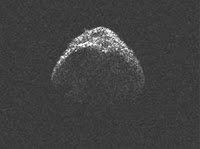2012 LZ1 Asteroid discovered on 10 June by the Siding spiral Observatory in Australia and capable as harmful by the Minor Planet Center, from colliding with the earth at least the next 750 years. The Puerto Rican Observatory Arecibo, which has one of the largest telescopes in the world at 305 meters in diameter, reported that by using the planetary radar system has determined that the orbit of the asteroid LZ1 not placed close enough to earth to collide in the next 7 and a half centuries, Efe reported.
The Arecibo Observatory statement clarifies that the LZ1 has a size twice as much as initially estimated, but after being examined on Tuesday by its specialists verified that there is no danger of collision with Earth up to that period. In addition, it was found that the LZ1 is spherical in shape, has a rotation period of 10 to 15 hours, and only reflects the 2 to 4 percent of the light that hits. "Sensitivity our radar allowed us to more accurately detect this asteroid and determine that this object will not impact the Earth at least the next 750 years, "said the director of the Arecibo Observatory, Mike Nolan. The team of scientists at the Arecibo Observatory who participated research consisted of Ellen Howell, Michael Nolan, Israel Cabrera, Jon Giorgini and Marina Brozovic. Arecibo Observatory LZ1 managed to take photos as it passed 10 million miles from Earth. Located in Arecibo, Puerto Rico's north The observatory is operated by the Stanford Research Institute (SRI) International in partnership with the Metropolitan University.





No comments:
Post a Comment